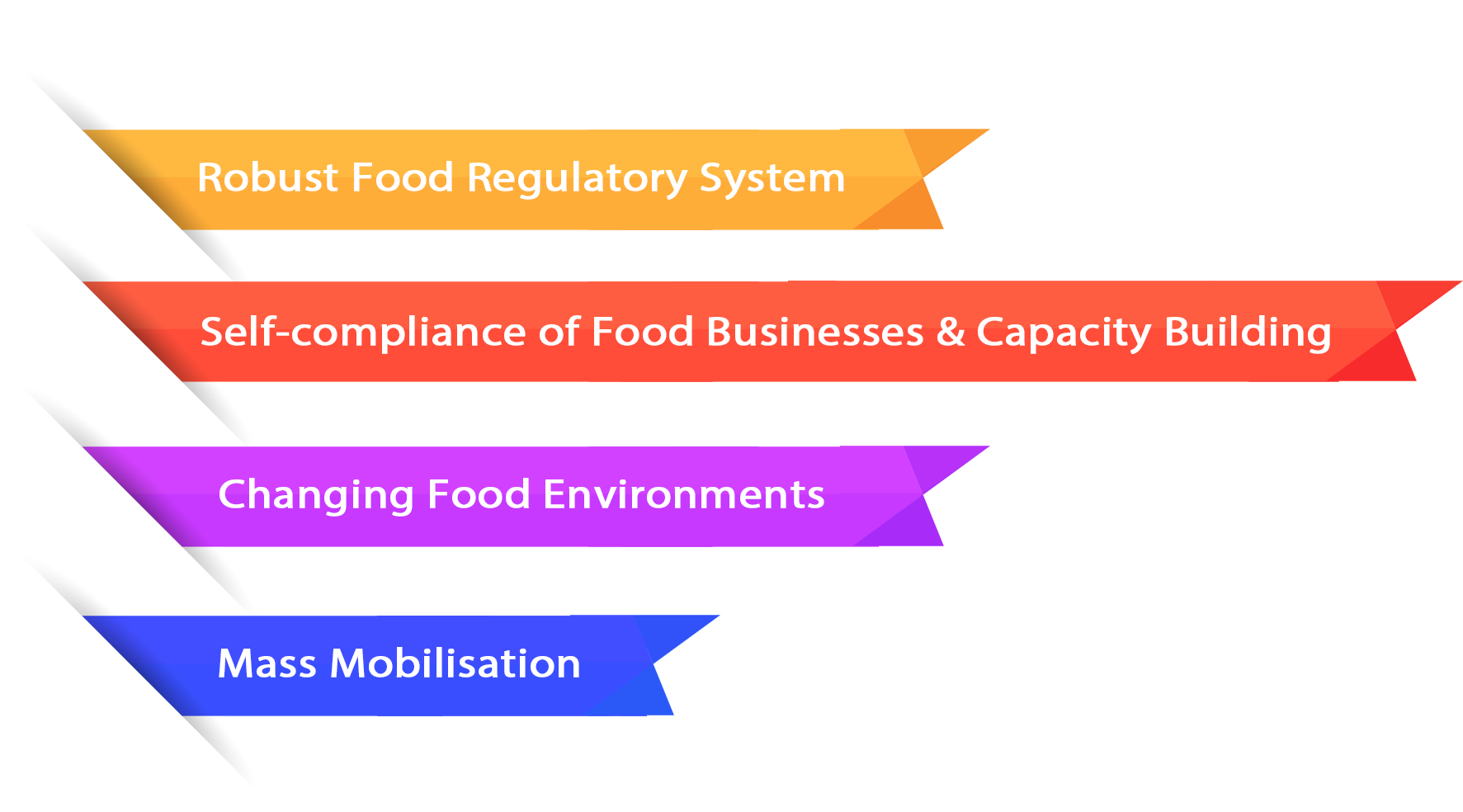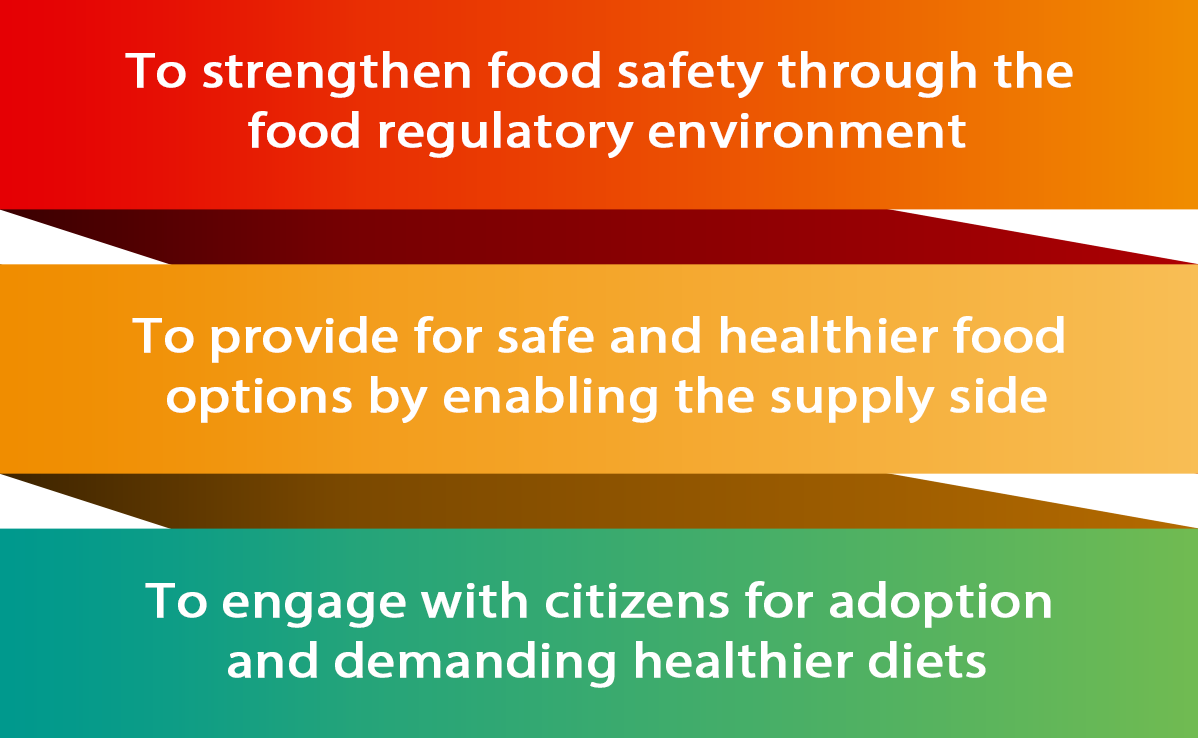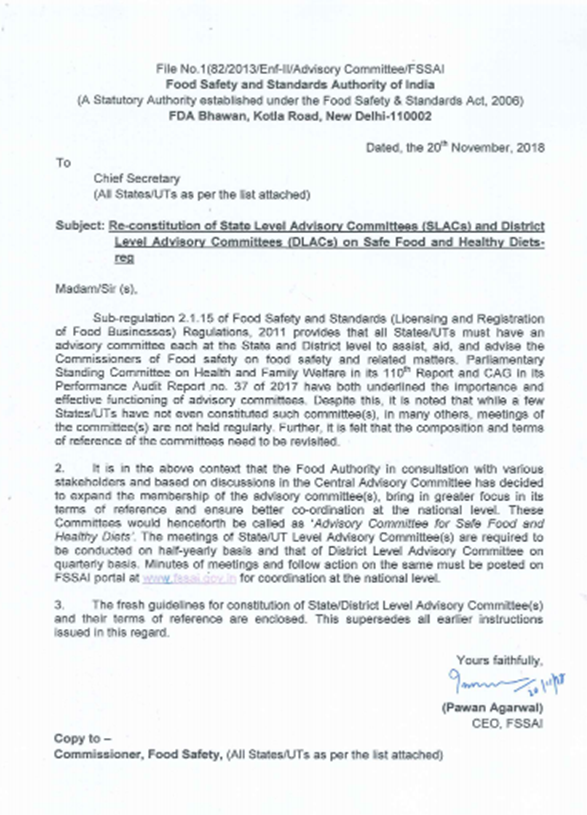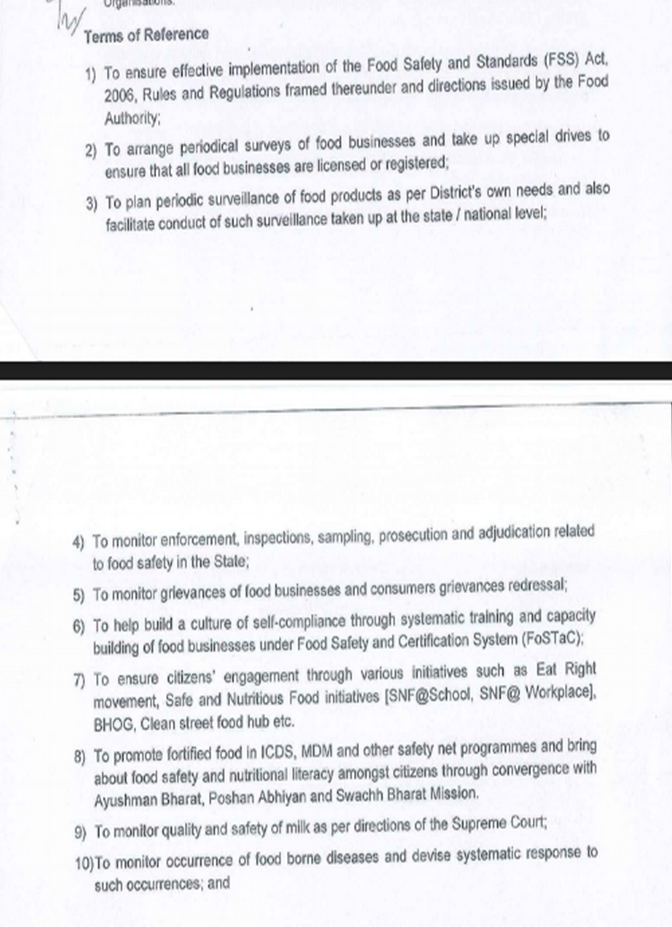About the challenge
Introduction
Food Safety and Standards Authority of India (FSSAI), has initiated the Eat Right India movement. The movement is based on three key themes, ‘if it’s not safe, it’s not food’ (safe food), ‘food should not only serve the palate but is also meant for body and mind’ (healthy diets) and ‘food has to be good both for people and the planet’ (sustainable diets).
The Eat Right Challenge is envisioned as a competition among districts and cities to recognize their efforts in adopting and scaling up various initiatives under Eat Right India. Further, it is meant to motivate states to improve performance and encourage others to join.
Heads of Municipal Bodies, Districts and Food Safety Commissioners are invited to take up Eat Right Challenge to ensure safe and healthy food for all.
Salient Features

The Eat Right India Movement is working on three key themes through a graded “Food Systems Approach” (FSA) to address these issues in a holistic manner by building on the collective action of all stakeholders - consumers, food businesses, community organizations, experts, professionals, and the government. Multiple actions, not only on the supply-side, but also on the demand-side are needed. Therefore, various actionables under the Challenge have been categorized under four sectors:
1. Robust food regulatory system: The food authority has taken informed steps to formulate new and strengthen the existing food standards in the country. This includes setting globally-benchmarked standards, credible food testing, surveillance and various enforcement activities. Through the Challenge, the aim is to broaden the reach of registration/licensing, enforcement, surveillance, among other core regulatory activities of FSSAI.
2. Self-compliance of food businesses and capacity building: Food may be contaminated with a variety of microorganisms at various stages across the supply chain – post-harvesting, storing, processing or during handling operations. Through training and certification of both big and small businesses, and unorganized vendors, self-compliance to regulations and standards set by the Authority can be achieved through a graded approach.
3. Changing food environments: Preventive healthcare is critical and lowers the burden of disease on the country and hence boosts productivity of its people. As food is a common thread linking citizens everywhere, the food authority’s approach is to transform the ‘food environment’ in the country to provide safe, healthy, nutritious, and sustainable diets to all. While doing so, engagement with both the consumers and the food industry is strengthened.
4. Mass mobilization: To make Eat Right India a people’s movement, the authority is planning to organise large-scale citizen-centric campaigns to bring about social and behavioural change. This includes awareness generation about reduction in the consumption of High Fat, Trans-fat, Salt and Sugar foods, while promoting consumption of local, seasonal and fortified foods for better health outcomes. This will create an environment of opting for informed healthier choices.
Expected outcomes

To strengthen food safety through the food regulatory environment: Under the Food Safety and Standards Act, 2006, the Food safety and Standards Authority of India (FSSAI) and the food safety administrations in the States / UTs are expected to create food environments where safe and wholesome food (food promoting good health and wellbeing) is available for all. This will ensure that a database of licensed/registered food businesses is available with FSSAI.
To provide for safe and healthier food options by enabling the supply side: The food environment today is working towards delivering healthy diets. They are still at the risk of malnutrition, and increasing incidence of foodborne illnesses. This can be addressed by adoption of healthier menus, reducing high fat, trans-fat, sugar and salt foods, and adequately disposing used cooking oil for production of biodiesel at the food industry end. Nudging the food businesses to provide for healthier options in their food menus and products is, therefore, necessary. Food safety can thus be achieved by building capacities of the businesses and ensuring self-compliance to regulations.
To engage with citizens for adoption and demanding healthier diets: Eat Right India is people’s movement with targeted promotion of dietary diversity and balanced diets, eating mindfully and timely, and promoting large-scale fortification of staples to address micronutrient deficiencies are some ways to encourage the consumer demand for healthier diets. This will ensure lower incidence of disease and increased focus on preventive healthcare through social behaviour change.
Eligibility Criteria
- All districts of the country. If a district has a city of population over 5 lakhs, it can register as a district.
- Cities (with more than 1 district) and a population of over 5 lakhs . For North East and Hill Stations, cities with a population of over 2 lakhs can register.
- The first 150 cities and districts that register on a first-cum-first service basis will be eligible for seed funding for the challenge.
- The remaining districts/cities will also be eligible for the challenge.
Steps for Implementation

-
step 1:Preparatory Phase
Convene and Create the City/District Level Committee.
- Municipal Authorities and Districts Magistrates will lead the Eat Right Challenge to ensure safe and healthy food for all.The Food Safety Commissioners of the State may also nominate the DO of chosen district/city for all purposes of the challenge.
- They must constitute a City/District Level Committee and convene its meeting along with other relevant stakeholders concerned with the food ecosystem, to deliberate upon the action plan for the Eat Right Challenge. The Committee will function as an Eat Right Team, which will be responsible for overseeing the implementation of the Challenge. For Districts, as per the direction vide no F.No. 1(82/2013/Enf-II/Advisory Committee/ FSSAI) dated 20th November 2018, a committee led by the District Collector (DC) with relevant stakeholders must be constituted, details of which are placed at Annexure 1.
- A Nodal Officer may be appointed for implementation of the Challenge. It is advised that for planning of the activities under the Challenge, the Team may meet every fortnight.
- The Team must discuss and create a plan of action to conduct activities, categorized under five sections, for the Challenge. The activities with detailed steps and resources like posters, videos, IEC material, etc. have been specified and placed at Annexure 2. Of the five categories, all activities under section A, C, and D are mandatory. From section B, only three activities have to be conducted. A minimum benchmark has been set for the cities/districts in each section, over and above of which they will compete against each other.
- There is a special provision at Section E for innovative activities. This will include any innovative idea envisaged by the city/district to conduct any of the activities which fall under FSSAI’s mandate, FSS Act, 2006, and other Eat Right Initiatives. Separate funding has been allocated on the basis of proposals shared by the city/district on a case-case basis.
- Once the action plan is created, the same must be uploaded online.
-
step 2:Online Registration
- The nodal officer will have to log on to https://fssai.gov.in/EatRightChallenge/home and create an account with username and password to register.
- The officer must choose to register as either city or district as per the eligibility criteria. Details of the head of the city/district administration, information of the nodal officer, details of the Designated officer, and bank account details must be furnished.
- Once the registration is complete, upon verification by FSSAI, the nodal officer can log on to the website using the chosen username and password.
- In case of any change in any of the information, the nodal officer must intimate FSSAI at the earliest at eatrightchallenge.fssai@gmail.com and revise the information submitted by him/her.
-
step 3:IMPLEMENTATION PLAN
- The activities must be implemented as per the self-set targets created by the city/district upon registration.
- The cities and districts are urged to begin the Challenge by branding themselves as “Eat Right (name of city or district)” for all purposes of the Challenge. The best branding done by a city/district will also be considered for receiving recognition from the Competent Authority. The print ready resources for the same will be available on the website.
- The Food Safety Commissioner in collaboration with the District Collector/ Municipal Commissioner must facilitate on-ground implementation of the challenge. Leveraging the convening power of the DC/MC, since most of the Eat Right Initiatives operate in a collaborative/convergent model, activities can be further amplified.
-
step 4:MONITORING AND EVALUATION
- A monthly progress report must be uploaded on the Eat Right Challenge website.
- The city/district can see its real-time performance on the dashboard on the website.
- Cities/districts must have an active social media presence for effective amplification of activities undertaken through pictures, videos, reports, etc.
-
step 5:Timelines, Awards and Recognition
Registration begins on the web portal from June 2020.
Financial Aid
FSSAI will provide seed funding of INR 5 lakhs to the first 150 cities/districts to register. The money will be disbursed in two phases - 50 percent immediately upon submission of the action plan to the Competent Authority, and the remaining 50 percent over the course of the Challenge.
For any innovative projects proposed, funds up to INR 5 lakhs will be provided on a case-case basis in two parts, over the course of the year, upon submission of the Activity Proposal on the website.
Funds may be directed and utilized from other national flagship programmes like POSHAN Abhiyaan, Ayushman Bharat, National Health Mission (NHM), Anaemia Mukt Bharat etc. may also be done to conduct the IEC activities. The city/district may also leverage Corporate Social Responsibility (CSR) funds by engaging with various types of organizations.
Bank details of District Collector / District Magistrate / Food Safety Commissioner is required to be filled for cash transfer.
A Utilization Certificate (UC) must be uploaded to obtain the next instalment. A second UC must be uploaded at the end of the challenge.
-
Annexure 1:Letter to the Chief Secretary for SLAC and DLAC
Letter to the Chief Secretary for SLAC and DLAC



-
Annexure 2:Activity Matrix and List of Detailed Activities
Activity / Performance Matrix
| S.No. | Activity | Minimum annual Benchmark | Minimum Marks | Target for Full marks | Full Marks |
|---|---|---|---|---|---|
| A. | Registration, Licensing, Surveillance and Enforcement Drive (All) | 35(All) | |||
| A1. | Registration and licensing drive | 10% increase in active license/registration | 2 | Full coverage or 100% increase | Upto 10% increase - 2 marks >10 - upto 15% increase - 3 marks >15% - upto 25% increase - 4 marks >25% - upto 30% increase - 5 marks >30% - upto 50% increase - 7 marks >50% increase - 9 marks |
| A2. | Surveillance drives | 3 drives with minimum 50 samples each | 2 | More than 8 drives | 3 drives: 2 marks 4 drives: 3 marks 5 drives: 4 marks 6 drives: 5 marks 7 drives:6 marks 8 drives:7 marks >8 drives: 9 marks |
| A3.a | Enforcement samples | 3 kind of drives with minimum 12 samples each | 2 | More than 18 samples per FSO per month | Sample is per FSO per month 3-6 samples: 2 marks 7-9 samples: 3 marks 10-12 samples: 4 marks 13-15 samples: 5 marks 15-18 samples:7 marks >18 samples: 9 marks |
| A3.b | Inspection using FoSCoRIS | 50% manufacturers | 4 | Atleast 50% manufacturers + 50% Food services + 50% rest of the licences - 8 marks | Licences Atleast 50% Manufacturers - 4 marks Atleast 50% manufacturers + 50% Food services - 6 marks Atleast 50% manufacturers + 50% Food services + 50% rest of the licences - 8 marks |
| B. | Capacity building and certification (Any three) | 30 (10 each) | |||
| B1. | FoSTaC | Training of 500 food handlers with at least 10% in advanced courses | 5 | Training of 2000 food handlers or more | 500 Food Safety Supervisor(FSS) - 5 marks Upto 1000 FSS – 7 marks Upto 2000 FSS - 9 marks >2000 FSS - 10 marks |
| B2. | Hygiene rating | Hygiene rating of 100 establishments | 5 | 500 establishments or more | 100 establishments – 5 marks 101 - 250 establishments – 7 marks 251 - 499 establishments – 9 marks >500 or more Establishments - 10 marks |
| B3. | Hub Certification-Clean Street Food Hub,BHOG,Clean and Fresh Fruit and Vegetable Market | 2 hubs covering atleast 2 types of sectors | 5 | 10 hubs or more | 2 hubs – 5 marks Upto 4 hubs – 7 marks Upto 6 hubs – 8 marks Upto 9 hubs- 9 marks 10 hubs or above-10 marks |
| B4. | No Food Waste Certification, RUCO | 25 Establishments in one/both initiative | 5 | 75 Establishments in one/both initiative | 25 Establishments-5 marks Upto 50 Establishments-7 marks Upto 75 Establishments—9 marks 75 Establishments or above-10 marks |
| B5. | Eat right toolkit - training of ANMs / ASHA workers / Anganwadi workers | 100% of frontline workers in any one category | 5 | 100% of frontline workers in all three categories | 1 category – 5 marks 2 categories – 7 marks 3 categories - 10 marks |
| C. | Eat right food environments (All) | 10 | |||
| C2. | Eat right campus | 3 campuses | 2 | 8 or more | 3 Campuses-2 marks Upto 4 Campuses-4 marks Upto 5 Campuses-6 marks Upto 7 Campuses-8 marks 8 or above Campuses-10 marks |
| D. | Changing Food Choices(Any Two) | 15(7.5 each | |||
| D1. | Promoting Eat Right Messages like posters, danglers, branding etc. in public places. List of public places and the key messages have been provided below. | Visibility in atleast 20 public spaces as per schedule provided below | 3 | Coverage in City / District | 20 places – 3 marks 30 places - 6 marks 40 or above places-7.5 marks |
| D2. | Play videos in cinema halls, public places | 10 public places across the year plan submitted by district/city | 3 | Coverage in City / District | 10 places – 3 marks 15 places - 6 marks 20 places or above -7.5 marks |
| D3. | Digital media outreach | 10000 impressions minimum | 2 | 50000 or more impressions | 10000- 2 Marks Upto 20000-4 marks Upto 40000-5 markss >50000-7.5 marks |
| E. | Innovative activities | 10 | |||
| Innovative activities that may be undertaken by the city/district to execute any of the activities which strengthen the FSS Act and other Eat Right Initiatives | NA | innovative activities selection on case-case basis | Equal Distribution of marks among all activities | ||
Register Now



